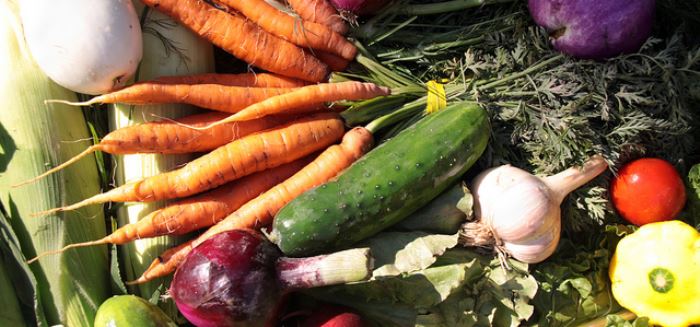Fall brings its own sets of tasks for Minnesotans — raking leaves, storing the lawn mower, getting that trusty snow shovel ready once again. It can also be a time to consider the bounty of the summer. In today’s post, Lee Ann Pomrenke reflects on her recent experience being a part of a CSA. As her post suggests, stewardship includes both the offering plate and the refrigerator.
Yours truly,
Adam Copeland, Center for Stewardship Leaders
Eating Our Values
Lee Ann M. Pomrenke
We bought into a CSA to support local agriculture; we keep coming back because it changes how we pay attention to our food. I open the weekly box of whatever-is-in-season, paid for in full last spring, as a gift of grace and accompanying challenge every Wednesday. After the variety of our summer CSA (Community Supported Agriculture) share, the selection of vegetables that grow in Minnesota in the fall are notably limited (would anybody like some squash?). Yet the challenge of our box remains the same; or should I say, the spiritual discipline? It is a discipline in our culture of excess and consumerism to cook, eat, or share what someone else has decided to give us, before it rots.
Feeding my family in this way is not just about us, though; it’s also about a dependable income for those who farm. And it has become about me branching out, experimenting, and paying attention to our food like I do not otherwise. It is about stewardship of our food, our farmer’s livelihood, and our attention to both.
I do not enjoy cooking. It stresses me out. My husband enjoys experimenting with food combinations, methods of cooking, and new ingredients. I have a purely utilitarian approach to the ordeal. We must eat, it ought to be healthy, and here’s the raw materials, so how can I put it together so we will all (including two kids) eat it? I immediately give away spicy peppers (because I know my limits). I’ve taken peppers to a graduation party, given them to a babysitter, and sent them with my spouse to give to co-workers. But peppers are the exception. Everything else I at least attempt to use.
Sometimes, the CSA box includes beets for several weeks in a row. If they’re small, sometimes they get pushed behind big leafy greens on the bottom shelf of the fridge and — oops — I end up avoiding them until it’s the weekend and my husband’s turn to cook. Then they reach their life’s pinnacle as a part of a creative borscht. Other times, there are just too many of them, and they come with the greens on, which I then suppose I also should use in some way.
Well, it turns out, cubed beets and sweet potato hash in the cast iron skillet are quite good, and beet greens behave in a quiche much like spinach or chard (another CSA frequent crop). This reluctant cook got backed into a corner of experimenting with the help of internet search engines.
It is a little bit about the money. We already spent it, back in the spring when we were so hungry for local produce after winter imports from hothouses or abroad. Every week around Monday, when our fridge is emptying out, I have a thought along the lines of: “I don’t want to buy carrots, because what if they give us garden-fresh carrots?” and I am strangely motivated to make even weirder meals until we see what will be in the box. For us, it’s more than a little about where our money goes.
Our CSA is not traditional farm-based but is part of a non-profit that provides employment for teenagers in our urban neighborhood while teaching them how to garden, cook, and conserve our earth’s resources. We are almost literally eating our values. Other CSAs are ways to ensure small family farms will have steady income, or help support organic farming techniques. Also, we are putting healthy food in our bodies, in quantities and varieties we might not otherwise choose. Food is a reliable way to challenge ourselves to live our values — putting our money where our mouths are — several times a day.
For More Information:
Lee Ann M. Pomrenke is a pastor in the St. Paul, Minnesota area. She blogs at leeannpomrenke.com.
Executive Certificate in Religious Fundraising: Luther Seminary, in partnership with the Lake Institute on Faith and Giving, is hosting a four-day intensive course, May 7-10, 2018. For more information visit: Lake Institute.



